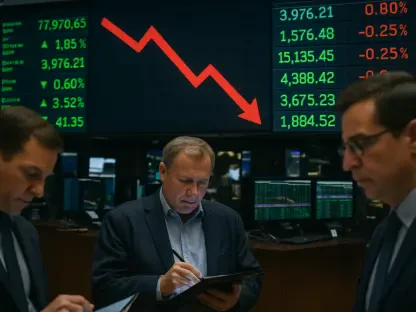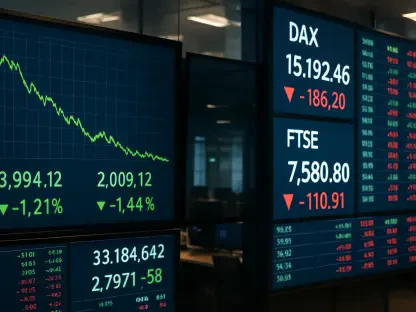In a striking reflection of worldwide financial turbulence, the Kuwait Stock Exchange (KSE) recently suffered a substantial loss of approximately 378 million Kuwaiti dinars in market capitalization during a single trading session on a Tuesday, plummeting from 52.935 billion to 52.557 billion dinars, as part of a broader global and regional market sell-off. This sharp decline, heavily influenced by a significant drop in major technology stocks and mounting concerns over potential delays in interest rate cuts by the US Federal Reserve, mirrors the struggles of international indices. As markets worldwide grapple with volatility, the KSE’s downturn underscores the interconnected nature of today’s financial systems. This event has sparked discussions among investors and analysts about the resilience of regional markets in the face of external economic pressures. The following analysis delves into the specifics of this decline, exploring its causes, the global context, and the unique factors that shape Kuwait’s market response.
Global Market Pressures and KSE’s Decline
The dramatic fall in the KSE’s market capitalization is closely tied to a cascading effect of declines across global financial hubs, highlighting how interconnected modern economies have become. Major indices such as Japan’s Nikkei 225 and South Korea’s Kospi each tumbled over 3%, while Wall Street experienced steep losses, particularly in technology and artificial intelligence-linked stocks like Nvidia. European markets were not spared either, with the STOXX 600 index dropping 1.1% to its lowest level since early November, and key exchanges in Germany and France shedding more than 1.2%. The primary drivers of this widespread downturn include fears of an overheated investment bubble in AI, investor caution ahead of delayed US economic data, and declining oil prices, all of which have fueled negative sentiment. For the KSE, this global unrest translated into significant losses across its main indices, with the general market index falling 0.72%, the First Market Index declining 0.7%, the “Main” Index dropping 0.8%, and the “Main 50” Index decreasing by 0.95%, despite a partial recovery from an initial 2% plunge at the session’s start.
Beyond the immediate figures, the KSE’s downturn reflects deeper anxieties about the trajectory of global monetary policies, particularly the US Federal Reserve’s stance on interest rates. A potential delay in rate cuts has rattled investors, as higher borrowing costs could dampen economic growth and corporate earnings worldwide. This uncertainty is compounded by the tech sector’s volatility, which has seen massive investments in recent years, raising concerns about sustainability. In Kuwait, the impact is felt across various sectors, with technology experiencing the steepest decline at 5.41%, while others like insurance and consumer services recorded marginal gains of 0.14% and 0.05%, respectively. The healthcare sector remained stable, illustrating the uneven effects of global pressures on different industries. These disparities suggest that while external forces play a significant role, internal market dynamics also influence how such shocks are absorbed within the KSE.
Resilience Amidst Volatility
Despite the substantial loss in market capitalization, the KSE showcased notable resilience through robust trading activity during the turbulent session. Liquidity surged by an impressive 43% to 128.76 million dinars, while traded volumes skyrocketed 64.4% to 722.50 million shares, and the number of transactions climbed 61% to approximately 38,180. Such figures indicate a strong risk appetite among investors, even in the face of adversity, suggesting that confidence in the market’s underlying strength remains intact. This high level of activity contrasts with the declines seen in market indices, pointing to complex investor behavior where profit-taking and bargain-hunting coexist. The ability to maintain such trading vigor during a downturn underscores a level of stability that sets the KSE apart from some of its regional counterparts, which often struggle with liquidity during volatile periods.
Further bolstering this resilience are Kuwait’s strong economic fundamentals, particularly in sectors like banking, finance, and real estate, which provide a buffer against global shocks. Unlike markets heavily exposed to technology and AI stocks, such as those in Dubai and Qatar, the KSE’s limited involvement in these volatile sectors has mitigated the severity of its losses. Expert insights reinforce this perspective, with analysts noting that foreign inflows have supported market liquidity since the start of the current year. Additionally, the absence of anticipated major changes in the upcoming MSCI review reduces technical pressures on the market. This combination of internal strengths and strategic positioning helps explain why the KSE, despite the significant financial hit, continues to be viewed as one of the top-performing markets regionally and globally in the current economic landscape.
Expert Insights on Market Dynamics
Delving into the psychological and strategic factors behind the KSE’s performance, analysts have offered nuanced perspectives on the recent downturn. Fawzi Al-Dhafeeri from Kuwait Investment Company described the market’s drop as largely sentiment-driven, influenced by global weaknesses and expectations of continued US monetary tightening. However, he highlighted the market’s robust fundamentals, emphasizing that high liquidity and sustained investor interest signal a capacity to weather external storms. This view suggests that while global trends exert undeniable pressure, the emotional response of investors plays a significant role in amplifying short-term declines. The KSE’s ability to partially recover from an initial sharp drop further supports the notion that panic-driven selling often gives way to more rational assessments of value over the course of a trading session.
Complementing this analysis, Raed Diab from Kamco Invest framed the declines as a natural correction following substantial gains earlier in the year, with investors seizing opportunities for profit-taking ahead of nine-month financial results. He pointed to Kuwait’s solid economic base as a stabilizing factor, arguing that the market’s performance remains strong compared to many international peers. This perspective underscores the cyclical nature of financial markets, where periods of growth are often followed by adjustments as investors reassess their positions. The emphasis on upcoming financial disclosures also highlights the importance of transparency and corporate performance in shaping market sentiment. Together, these expert opinions paint a picture of a market caught in global crosswinds but grounded by local strengths, offering a balanced outlook for stakeholders navigating these challenging conditions.
Reflecting on a Path Forward
Looking back, the substantial 378 million dinar loss at the KSE stood as a stark reminder of the vulnerabilities inherent in a globally connected financial system, where declines in technology stocks and uncertainties over US interest rates reverberated through markets worldwide. Yet, amidst this turbulence, the KSE demonstrated a capacity to endure, buoyed by vigorous trading activity and limited exposure to the most volatile sectors. Moving forward, stakeholders should focus on leveraging Kuwait’s strong economic fundamentals to further insulate the market from external shocks. Close monitoring of global monetary policy shifts, particularly from the US Federal Reserve, will be crucial in anticipating future pressures. Additionally, enhancing sector diversity and sustaining high liquidity could serve as vital strategies to maintain investor confidence. As the financial landscape continues to evolve, the KSE’s ability to adapt while preserving its core strengths will likely determine its trajectory in an unpredictable global economy.









